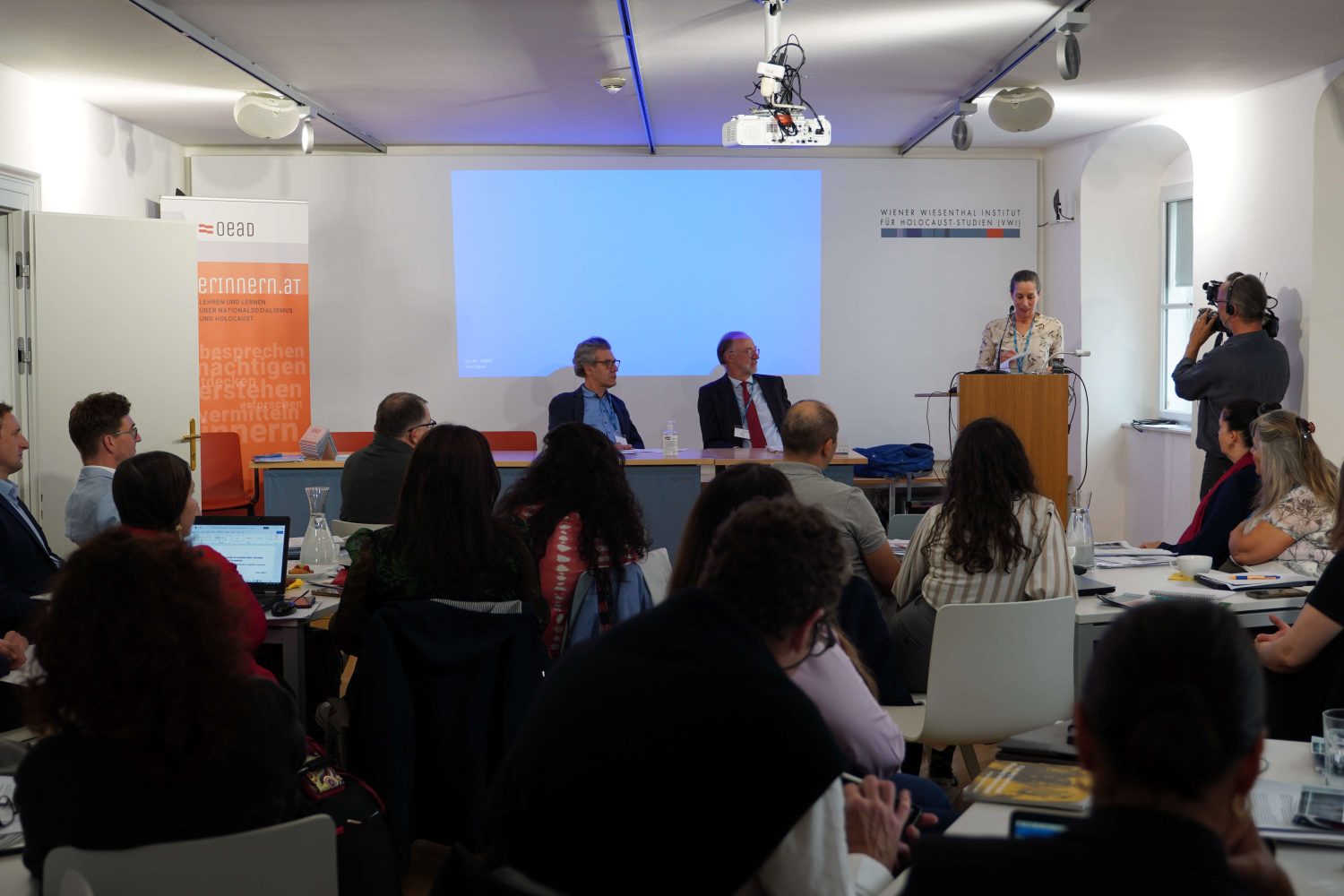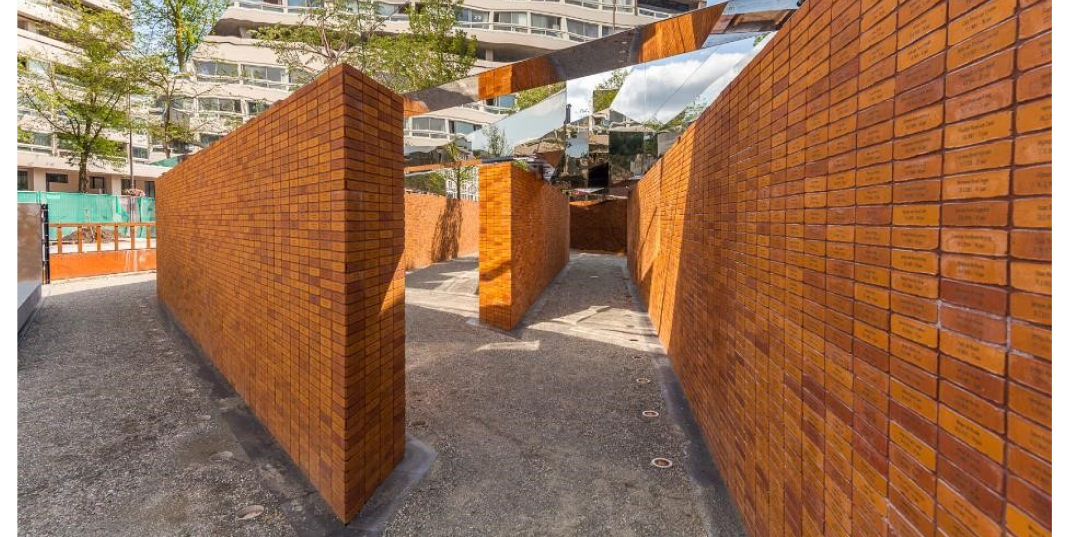
See all countries
- Argentina
- Australia
- Austria
- Belgium
- Bulgaria
- Canada
- Croatia
- Czech Republic
- Denmark
- Estonia
- Finland
- France
- Germany
- Greece
- Hungary
- Ireland
- Israel
- Italy
- Latvia
- Lithuania
- Luxembourg
- Netherlands
- North Macedonia
- Norway
- Poland
- Portugal
- Romania
- Serbia
- Slovakia
- Slovenia
- Spain
- Sweden
- Switzerland
- United Kingdom
- United States of America
Joined the IHRA
1999
International Holocaust Remembrance Day
27 January
Aaf Tiems (Ministry of Health, Welfare and Sport, Netherlands) – Head of Delegation
Cristan van Emden (National 4 and 5 May Committee) – Deputy Head of Delegation – Academic Working Group
Nanci Adler (NIOD Institute) – Academic Working Group
Marc van Berkel (Radboud University Nijmegen) – Education Working Group
Annemiek Gringold-Martinot (Jewish Cultural Quarter) – Museums and Memorials Working Group
Jurmet Huitema-de Waal (Anne Frank House) – Education Working Group
Bas Kortholt (Herinneringscentrum Kamp Westerbork) – Museums and Memorials Working Group
IHRA membership has, without a doubt, influenced policymaking, and remembrance of, research on and education about the Holocaust in the Netherlands. International projects and exhibitions between Dutch museums and research institutions have emerged, a virtual reality educational tool was developed and researched, and contributions were made to the redesign of the site of former German Nazi-concentration camp Sobibór.
Under the Dutch Chairmanship of the IHRA, reports by member countries were established. Furthermore, a multi-lingual digital exhibition on the genocide of the Sinti and Roma was launched, a Masters program on the Holocaust was developed, and in 2010 two academic centers merged to become the NIOD, Institute for War, Genocide and Holocaust Studies.
Holocaust education, remembrance, and research in the Netherlands
All IHRA Member Countries are asked to complete a basic questionnaire with key facts about the state of Holocaust education, remembrance, and research in their country. The answers to the questionnaire, and to the Country Report, if available, are provided by the national delegations, who are also responsible for keeping the information up to date.
- On Sunday, 19 May 2019, State Secretary Paul Blokhuis spoke at the commemoration of the 75th anniversary of the ‘zigeunertransport’ from Camp Westerbork to Auschwitz. The State Secretary acknowledged that for too long the Roma genocide had been neglected as had the suffering of Sinti and Roma in The Netherlands during WWII
https://open-pilot.overheid.nl/Details/ronl-feac533e-9edc-4052-a259-18c5357dd3db/1?hit=15&sort=relevance-desc&count=20&thema_filter=c_2408fb5a&thema=c_2408fb5a&organisatie=mnre1025&informatiesoort=c_2aedadff - On Sunday, 26 January 2020, Prime Minister Mark Rutte apologized for the fact that civil servants working in the Netherlands during the Nazi occupation had not done more to prevent the deportation and murder of more than 100,000 Jews. https://www.government.nl/documents/speeches/2020/01/26/speech-by-prime-minister-mark-rutte-at-the-national-commemoration-at-the-auschwitz-monument-amsterdam
- On Remembrance Day 4 May 2020, HM King Willem Alexander acknowledged that during WWII his great grandmother as most other Dutchmen had shown too little resistance against the Nazi attitude towards Jewish countrymen and compassion with the fate of the Jews https://www.koninklijkhuis.nl/documenten/toespraken/2020/05/04/toespraak-van-koning-willem-alexander-nationale-herdenking-4-mei-2020
- On Sunday 19 September 2021, Prime Minister Rutte spoke at the opening ceremony of the Holocaust Monument of Names
https://www.rijksoverheid.nl/documenten/toespraken/2021/09/19/toespraak-minister-president-rutte-bij-opening-holocaust-namenmonument - On 13 October 2021, Minister Ollongren of Home Affairs and Kingdom Relations delivered 4 pledges to the Malmö Forum
https://open.overheid.nl/repository/ronl-58588ac0-a19e-493b-8a4e-e8901e2e2f70/1/pdf/Pledges%20of%20the%20Netherlands%20to%20the%20Malm_%20Forum.pdf
Countering antisemitism
1. Antisemitism rears its ugly head in many places. The diversity of patterns of antisemitism causes a wide range of organizations into action against antisemitism. The focus of these organizations ranges from security and criminal prosecution to research and education.
In order to connect the organizations and to improve the efficacy of combating antisemitism the Dutch government has appointed The National Coordinator for Combating Antisemitism (NCAB) on 1 April 2021. An annual budget of € 0.5M is guaranteed. The recently launched workplan categorises the activities against antisemitism in the Netherlands, namely:
1) Monitor and follow up
2) Education and prevention
3) Commemorate and celebrate
The launch of the work plan is expected in Fall 2022. More information can be found at www.antisemitismebestrijding.nl.
In the years 2019-2021, Parliament approved 1 million euros extra per year for combating antisemitism. In addition to existing policies on Holocaust education, citizenship education and awareness in football, twelve projects have been financed from these funds. Many of these projects encountered Corona which has hampered the planned execution of the projects. The NCAB is tasked to provide advice regarding the follow-up of projects that were financed from these funds and on future projects, if new funds are made available
– Fiche: Mededeling EU strategie aanpak antisemitisme | Tweede Kamer der Staten-Generaal (12 November 2021)
– Detail 2021D09772 | Tweede Kamer der Staten-Generaal (11 March 2021)
On specific issues the NCAB will work closely with the National Coordinator against Discrimination and Racism (NCDR).
2. State Commission against Discrimination and Racism (Link)
A State Commission against Discrimination and Racism is appointed for four years with the task to provide insight into the state of racism and discrimination in the Netherlands and advises the government on this topic. Research done by the State Commission will focus on all sectors of the society, including a review for discrimination and ethnicity profiling within the government. Based on the investigation, the State Commission will advise the government on improving policies and regulations to combat discrimination and racism.
3. The National Coordinator against Discrimination and Racism commended his activities October 1 2021. More information at https://www.bureauncdr.nl
The NCDR’s mission is:
• Consulting with and maintaining relationships with social initiatives, movements and interest groups, as well as with relevant governing bodies and companies.
• Drawing up a National Program consisting of a multiannual part and an annual action program;
• Encouraging all stakeholders to achieve the goals of the National Program
The National Program was launched on 19 September 2022.
Countering Antigypsyism/ anti Roma discrimination
In line with the European framework, the Netherlands pursue a generic policy to promote the equality, inclusion, and participation of the Roma and Sinti (the term Roma and Sinti refers to: Roma, Sinti, Kale and related groups in Europe, including Travellers and the Eastern groups (Dom and Lom), and covers the wide diversity of the groups concerned, including persons who identify themselves as Gypsies). Where necessary, specific measures are implemented.
Dialogue – Roma en Sinti | Kennisplatform Inclusief Samenleven (kis.nl)
The National Roma Contact Point (NRCP) initiates a dialogue between representatives of the Roma and Sinti communities and the various ministries developing policies touching on these communities. The dialogue with the Roma and Sinti communities has taken place twice in the form of a pilot.
Guide for municipalities
A guide has been developed that helps municipalities counter racism and discrimination. This guide includes a chapter on antigypsyism. The guide has been developed with the involvement of communities, including Roma and Sinti members.
Subsidy to improve social position
The Netherlands have a participation and emancipation subsidy scheme in place for Roma and Sinti. These subsidies are granted to fund projects and activities that, directly or indirectly, contribute to improving the social position of Roma and Sinti in the Netherlands. This is in recognition of observed shortcomings in the post-war restoration of rights. The post-war restoration of rights has been an instrument to remedy material injustice as much as possible. With this subsidy scheme, the remaining legal remedies are distributed among the Sinti and Roma communities.
Monitor Social Inclusion – Sociale Inclusie (meting 4) | Rapport | Rijksoverheid.nl
The exact number of Roma and Sinti in the Netherlands cannot be determined, as the Netherlands do not register citizens on the basis of ethnicity. The starting point is self – identification. This has consequences for quantitative research. Since 2013, the level of social inclusion of Roma and Sinti is investigated every other year in the Social Inclusion Monitor. Various qualitative methods are used to obtain a sound picture of the development and expectations for the future with respect to education, labor, health, housing, security and experienced anti-gypsyism/anti-Roma discrimination within these domains. The Social Inclusion Monitor will be held in 2023 and 2025 and will give insight on how the living conditions are currently being experienced by Roma and Sinti (former Monitors Social Inclusion Roma and Sinti were previously held in 2013, 2015, 2017 and 2019).
Bob Entrop’s interview collection presented online in a museological setting
Bob Entrop interviewed several Dutch Sinti and Roma that survived Porajmos. Bob Entrop’s interview collection is a unique historical source about Antizigypsyism in the past and present. Late 2021 Camp Westerbork Memorial Center, assisted by Bob Entrop adapted the original footage to current museum standards, and for permanent exhibition. The visitors can watch the interviews in a museum translation permanently from December 2021. In 2023, the website of the Memorial Center will be transformed into a digital information beacon about Camp Westerbork. The beacon will improve accessibility of the knowledge available the Memorial Center. It is expected that visitors will have a richer experience of the Camp because of the beacon.
Finally, the content and message of Bob Entrop’s interviews will be disseminated online via the various social media channels of the Camp Westerbork Memorial Center. The target group here is not only the general online audience of the Memorial Center – the Social Media channels of the Remembrance Center had a monthly joint reach of approximately 12,500 people in 2020 (Facebook 7,000 – 7,500, Twitter 2,000 – 2,500, Instagram 2,000, LinkedIn 1,000). Most important notice on social media is that especially the Sinti and Roma communities themselves explore the Bob Entrop collection by social media. This is known through Bas Kortholt’s exploratory study among the Sinti and Roma communities in 2020 and 2021.
- National Commemoration of the Holocaust is every year on the Sunday closest to 27 January – organized by the Nederlands Auschwitz Comité (Dutch Auschwitz Committee) with support of the National Committee 4 and 5 May.
- 4 May is Remembrance Day in The Netherlands. The official text of the Memorandum for Remembrance Day on 4 May reads ’During the national commemoration of Remembrance Day we remember all – civilians and soldiers – who have been killed or murdered in the Kingdom of the Netherlands or anywhere else in the world in war situations or during peacekeeping operations since the outbreak of the Second World War.’
- Nooit Meer Auschwitz lezing (Never Again Auschwitz lecture) is every year on the Wednesday before the commemoration of Holocaust Remembrance Day.
- Every year Kristallnacht is commemorated in the Portuguese synagogue in Amsterdam, and in other cities.
- Every 5 years NM Kamp Westerbork organizes the reading aloud of all 102.163 names of persons that fell victim to deportation to and murder in nazi concentration and extermination camps. January 2020 was the last occurrence of this event.
- Local organizations organize numerous Holocaust and Porajmos commemorations.
In the aftermath of the signing of the Stockholm Declaration, the NIOD Institute for War, Holocaust and Genocide Studies (Royal Netherlands Academy of Arts and Sciences) and the University of Amsterdam dedicated a special chair in Holocaust and Genocide Studies (from 2002) for B.A. M.A. and Ph.D. teaching and supervision. The ministry of Health, Welfare and Sports finances this chair out of its responsibility for War Victims and Remembrance.
Over the last years, several interesting studies and publications about the Holocaust and Porajmos have been published. The list underneath is neither complete nor covering the full spectrum of publications.
L. Vastenhout, Between Community and Collaboration: ‘Jewish Councils’ in Western Europe under Nazi Occupation. Cambridge: Cambridge University Press, 2022.
B. van der Boom, De politiek van het kleinste kwaad: een geschiedenis van de Joodse Raad voor Amsterdam, 1941–1943. Amsterdam: Boom, 2022
W. de Lang, De razzia’s van 22 en 23 februari 1941 in Amsterdam: het lot van 389 joodse mannen. Amsterdam: Uitgeverij Atlas Contact, 2021.
P. Romijn, De lange Tweede Wereldoorlog. Amsterdam: Uitgeverij Balans, 2020.
P. van den Boomgaard, Voor de nazi’s geen Jood: hoe ruim 2500 Joden door ontduiking van de rassenschriften aan de deportaties zijn ontkomen. Hilversum: Verbum, 2019.
R. Kok and E. Somers, De Jodenvervolging in foto’s: Nederland 1940–1945. Zwolle: WBooks, 2019.
H. Piersma, Op eigen gezag: politieverzet in oorlogstijd. Amsterdam/Antwerpen, Querido, 2019.
K. Happe, Veel valse hoop: de jodenvervolging in Nederland 1940–1945. Amsterdam: Atlas Contact, 2018.
J. Houwink ten Cate and B. Moore, Het geheime dagboek van Arnold Douwes, jodenredder. Amsterdam: Boom, 2018.
T. Gerritse, Rauter: Himmlers vuist in Nederland. Amsterdam: Boom, 2018.
L. de Jong, Jodenvervolging in Nederland, 1940–1945, ed. C. Kristel, B. Smits, F. van Vree. Hilversum: Uitgeverij Verbum, 2018.
No such surveys are known.
The constitutional freedom of education means that schools and teachers are free to choose the way in which they teach subjects to children. The legal requirements regarding the curriculum in primary education – the educational content prescribed – are regulated through core objectives and attainment targets. Because there is no centralized curriculum in the Netherlands and a free textbook market, there are many different textbooks on history education and other school topics in primary and secondary education. These textbooks are being updated regularly, either through the publications of new editions or through refurbished web support. Publishing companies are reluctant in displaying their business outcomes; we therefore do not know exactly what the relative market shares of the different textbooks are. An educated estimation would come up with five major history textbooks/publishers for secondary education: Memo/Malmberg, Feniks/Thiememeulenhoff, Geschiedeniswerkplaats/Noordhoff, Forum/Boom, Tijd voor Geschiedenis/Idem. The last textbook is completely web-based, the other ones offer web-versions.
In general, the genocide on the Sinti and Roma is hardly or not at all represented in textbooks in primary, secondary or higher education, with the exception of some university courses that specialize in the Holocaust and other genocides (Amsterdam, Nijmegen). One of the publications that is being used for education in this context, is this booklet, published in 2012 by the NIOD Institute for War, Holocaust and Genocide Studies: The Holocaust and Other Genocides – NIOD. Furthermore, an interesting collection of sources and materials on the Sinti and Roma history and genocide are published here: Sinti en Roma – Tweedewereldoorlog.nl. This website is updated regularly.
Late October 2021 Marc van Berkel, former chair of IHRA’s EWG, published Oorlog in de Klas (War in the classroom) the outcomes of the survey into the beliefs and goals of teachers at secondary schools with regards to WWII and the Holocaust. The survey addressed also textbooks, other teaching materials and the value of museums and memorials or education.
The survey was financed by the ministry of Public Health, Welfare and Sports (VWS). VWS is the ministry responsible for War Remembrance and the Netherlands delegation to IHRA.
As mentioned in the 2020 country report remembrance of the Holocaust in the Netherlands takes place in the context of commemorations of WWII. The 2020 country report already stated that in the Netherlands the Holocaust is presented within the context of WWII. The context for the 4 remembrance centers linked to the internment and deportation of Jews, Sinti and Roma and political prisoners offers more space for the Holocaust. Other memorial centers, museums and the 50 smaller war museums in the Netherlands devote limited attention to the Holocaust. These museums’ collections focus on warfare and resistance in the Netherlands and the Dutch East Indies.
Since 2012, the Foundation for Museums and Remembrance Centers 40-45 (SMH) has emerged from the directors’ consultations of a number of WW2 museums and institutions. Fifteen of the largest Dutch museums and WW2 memorial centers are represented within SMH:
- Airborne Museum ‘Hartenstein’, Oosterbeek
- Bevrijdingsmuseum Zeeland, Nieuwdorp
- Fries Verzetsmuseum, Leeuwarden
- Herinneringscentrum Kamp Westerbork, Hooghalen
- Nationaal Holocaust Museum i.o. en Hollandsche Schouwburg (JCK), Amsterdam
- Indisch Herinneringscentrum, Den Haag
- Museon, Den Haag
- Nationaal Monument Oranjehotel, Den Haag
- Nationaal Monument Kamp Amersfoort, Amersfoort
- Nationaal Monument Kamp Vught, Vught
- Nationaal Onderduikmuseum, Aalten
- Oorlogsmuseum Overloon, Overloon
- Museum Rotterdam ‘40-45’ NU, Rotterdam
- Verzetsmuseum Amsterdam, Amsterdam
- Vrijheidsmuseu, Groesbeek
Together with the Anne Frank House (AFS), these museums form the ‘defining museums’ on War Remembrance in The Netherlands.
Archival collections are mostly available in the Nationaal Archief, Dutch National Archives. A comprehensive overview can be found at https://www.tweedewereldoorlog.nl/kennis/bronnen/archieven/ (in Dutch). Het Netwerk Oorlogsbronnen provides a single digital access to multiple sources of war related materials (https://www.oorlogsbronnen.nl – in Dutch). The digital remembrance of Jews (https://www.joodsmonument.nl/en/) portrays all over 104.000 Dutch Jews that were deported and murdered in the Holocaust.
The EHRI portal provides an even more complete overview (https://portal.ehri-project.eu/institutions?country=nl – in English)
In the B2B newsletter, SMH paid attention to the International Memorial Museums Charter. SMH has also held workshops on the Charter and promoted the material in educational meetings.
A comprehensive overview of this kind does not exist. Different administrative levels are involved in funding the work of organizations working in the field of remembrance of Holocaust and Porajmos. At the level of national government, several ministries are committed to funding these activities. This includes funds not earmarked for activities of the kind asked for in this question.
The ministry of Health, Welfare and Sports finances the basic infrastructure for Holocaust and war remembrance in The Netherlands. As such, the ministry finances among others the memorial centers, the national committee 4 and 5 May and financially supports the cooperation mechanisms in the national remembrance domain.
With regard to important policy statements of the Kingdom of the Netherlands on genocide or mass atrocity crimes, the following situations are addressed below: (1) the situation of the Rohingya, (2) the situation of the Uyghurs, (3) the issue of the Armenian genocide, and (4) the situation of the Yezidi’s.
Myanmar / Rohingya
On the 1st of July 2019 the House of Representatives adopted a motion (See A) noting that, with regard to the Rohingya population in Myanmar, there are serious suspicions of genocide, possibly with state responsibility. Additionally, the motion requested the Dutch Government to assess whether the Kingdom of the Netherlands could, in collaboration with like-minded states, file a case before the International Court of Justice (ICJ) against Myanmar on the basis of the Genocide Convention of 1948.
On 22 July 2022, the Dutch Government issued a joint statement (See B) with Canada concerning the reaffirmation of the joint intention to intervene in the case The Gambia v. Myanmar before the ICJ. Whether or not genocide has been committed against the Rohingya is up for determination by the ICJ.
a. Motion by Member of Parliament Koopmans c.s., the House of Representatives of the Netherlands (Tweede Kamer), 1st of July 2019 https://zoek.officielebekendmakingen.nl/kst-32735-248.html, 32 735, nr. 248.
b. Joint statement of Canada and the Kingdom of the Netherlands regarding today’s decision of the International Court of Justice in the Rohingya genocide case between The Gambia and Myanmar, Dutch Ministry of Foreign Affairs, 22nd of July 2022 (LINK).
China / Uyghurs
The House of Representatives has been discussing the possible genocide against the Uyghurs in February 2021. Former Minister of Foreign Affairs (Blok) dissuaded the motion of member Sjoerdsma in February 2021 (See A), while emphasizing that the situation in Xinjiang is very worrisome (See B). He reiterated the government’s position that, before the very weighty recognition of genocide, there must be a determination by the UN Security Council, a judgement of an international court or tribunal, or unequivocal scientific conclusions. Later, in June 2021, the government’s position was restated in another letter from the Minister of Foreign Affairs (See C) and in a ‘question and answering’-session in July 2022 (see D). In the latter session, the government stated that – together with a representative number of EU member states – it was looking into the possibility of jointly recognizing certain situations as genocide and the possible conditions that might govern such joined recognition.
a. Motion by Member of Parliament Sjoerdsma c.s., the House of Representatives of The Netherlands (Tweede Kamer), 25 February 2021 (LINK), 21 501-02, nr. 2284.
b. Letter from the Minister of Foreign Affairs, Dutch Cabinet (Tweede Kamer), 22 April 2021 (LINK), 21 501-02, nr. 2323, p. 4.
c. Letter from the Minister of Foreign Affairs, Dutch Cabinet (Tweede Kamer), 4 June 2021 (LINK), 35 207, nr. 42, p. 4.
d. Answer to questions by Member of Parliament Sjoerdsma on the situation with regard to the Uyghurs, The Dutch Ministry of Foreign Affairs (Ministerie van Buitenlandse Zaken), 15 July 2022 (LINK), 2022Z11774, p. 3.
Armenia / Armenian genocide
On 25 February 2021 the Dutch House of Representatives adopted a motion (See A) noting that the Dutch Government had never recognized the Armenian genocide. The House of Representatives formally requested the Government to recognize the Armenian genocide.
In the Dutch Coalition Agreement (See B) of 15 December 2021, the Government elaborates on the criteria that have to be met in order for a situation to be recognized as genocide. In this regard, judgments of international courts and tribunals, scientific research and/or UN Security Council determinations are important factors in the recognition as genocide. Noteworthy, in March 2017, a Dutch Advisory Committee on Public International Law (the CAVV/EVA) published an advice (See C) on the use of the term genocide by Dutch politicians and parliamentarians. This advice was limited to ongoing situations, thus leaving aside historical issues. The advisory committee stated that historical issues, such as the issue of the Armenian genocide, should be dealt among the parties concerned, through compensation and apologies. The Dutch Government has formally responded (See D) to this advice and has so far not recognized the Armenian genocide.
a. Motion by Member of Parliament Voordewind c.s., the House of Representatives of the Netherlands (Tweede Kamer), 25th of February 2021 (LINK), 21 501-02, nr. 2277.
b. Omzien naar elkaar, vooruitkijken naar de toekomst, Cabinet, 15th of December 2021 (LINK).
c. Advies inzake mogelijkheden, betekenis en wenselijkheid van het gebruik door politici van de term genocide, Advisory Committee on Issues of Public International Law and External International Law Advisor (CAVV/EVA), March 2017 (LINK).
d. Letter of the Dutch Minister of Foreign Affairs, Dutch Cabinet, 22nd of December 2017 (LINK), 34 775, nr. 44.
Syria and Iraq / Yezidis
Relating to the situation of the Yezidis in Syria and Iraq, all parties of the House of Representatives agreed upon the use of the term ‘genocide’ in this situation. On 6 July 2021, the House unanimously agreed to the motion of member Kuik c.s. (See A) to qualify the crimes committed by ISIS against the Yezidi population as genocide. As mentioned in this motion, sufficient factual information was available to determine that ISIS is “highly likely” to have committed very serious international crimes, including genocide and crimes against humanity, against the Yezidi’s. The wording “highly likely” has been used as the government – in its possible recognition of the crime of genocide – looks at the judgements of international courts and criminal tribunals, unequivocal conclusions following scientific research and determinations by the UN Security Council. Before this motion, in January 2018, a ‘question and answering’-session took place with the former Minister of Foreign Affairs (See B) concerning multiple issues relating to the possible recognition of genocide committed in Syria and Iraq.
a. Motion by Member of Parliament Kuik c.s., the House of Representatives of The Netherlands (Tweede Kamer der Staten-Generaal), 1 July 2021 (LINK), 29 754, nr. 610.
b. List of Questions and Answers, the House of Representatives of The Netherlands (Tweede Kamer der Staten-Generaal), 5 January 2018 (LINK), 34775 V, nr. 45, p. 2 & 4.






